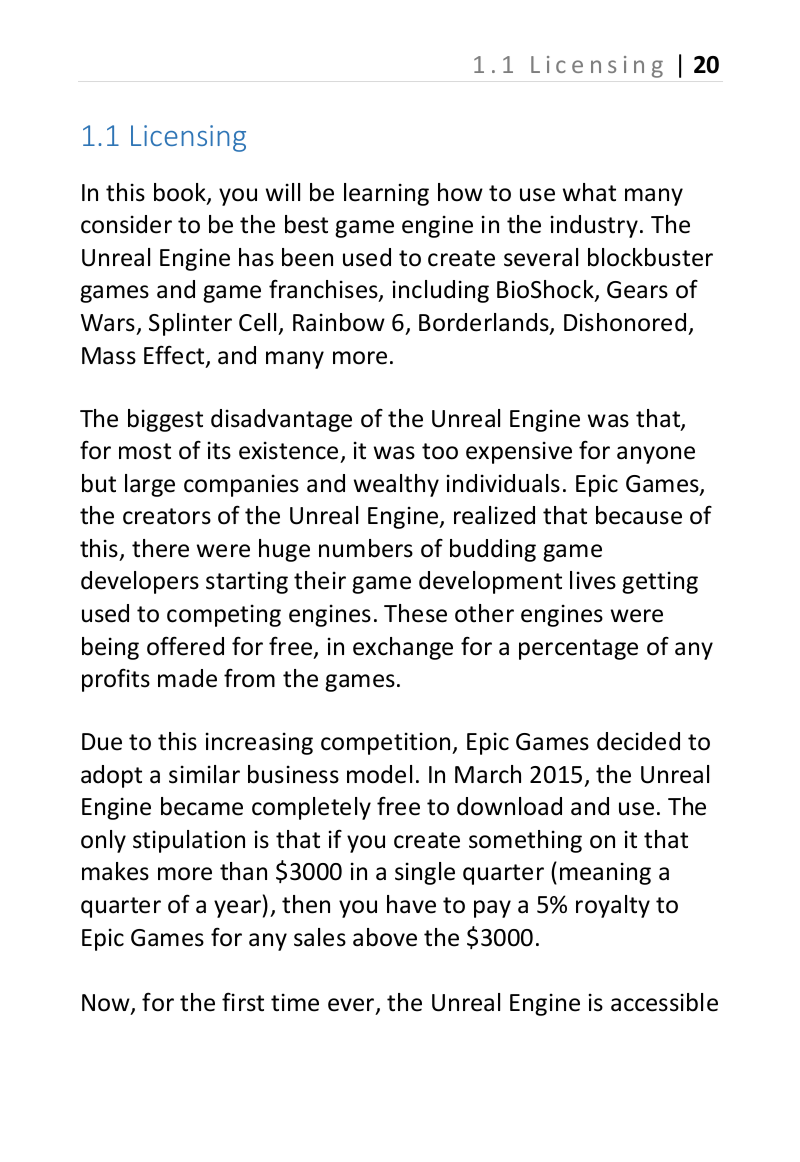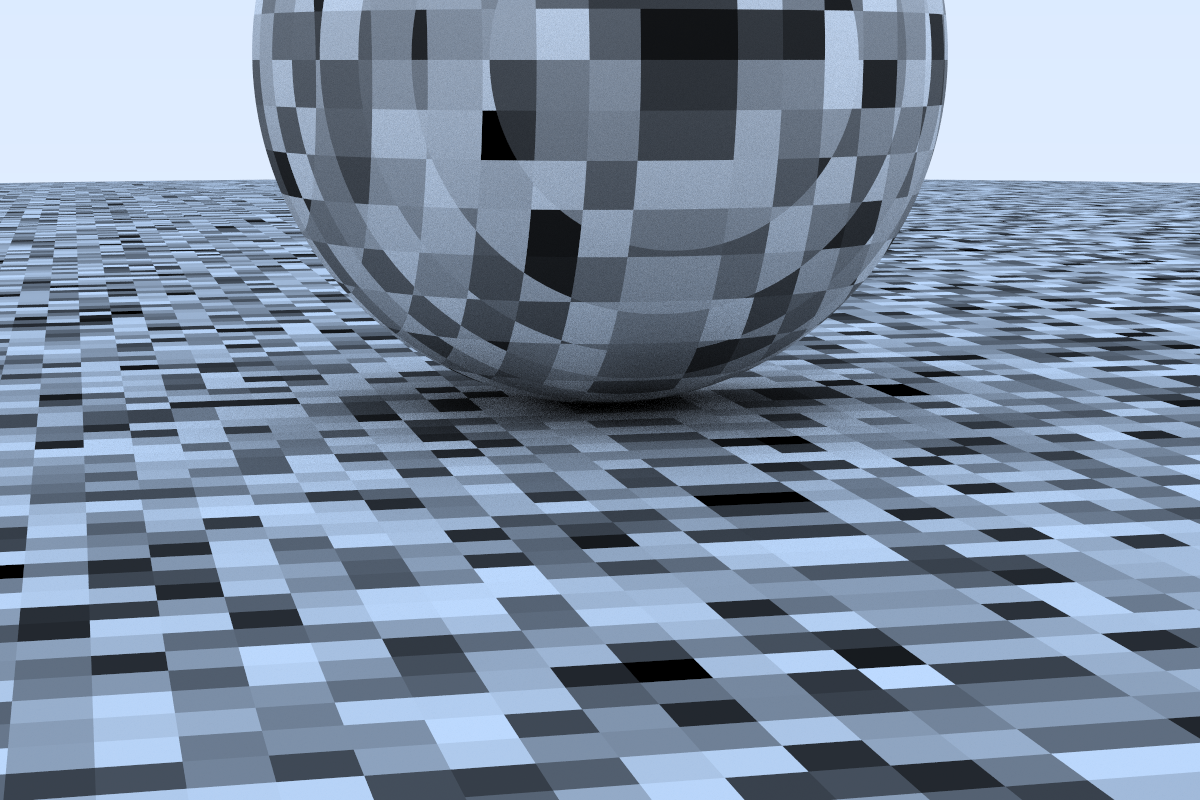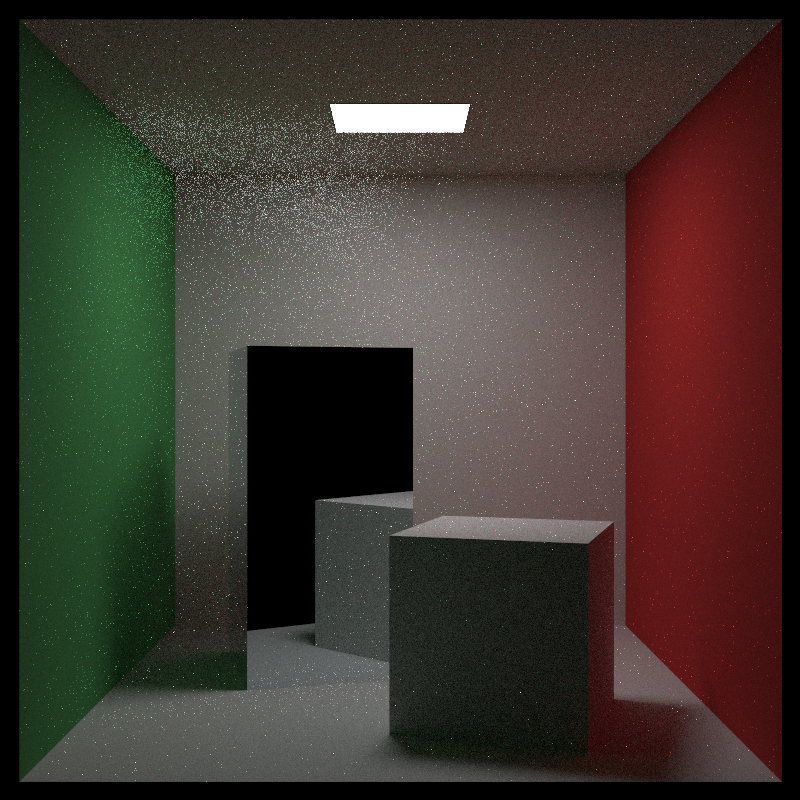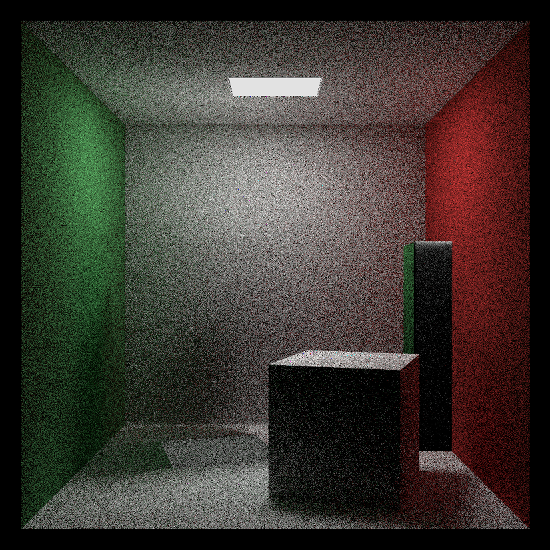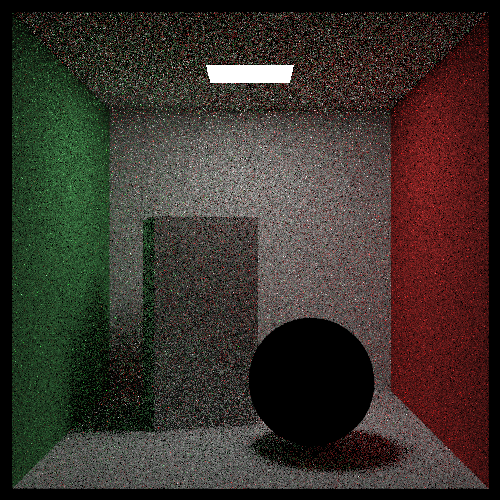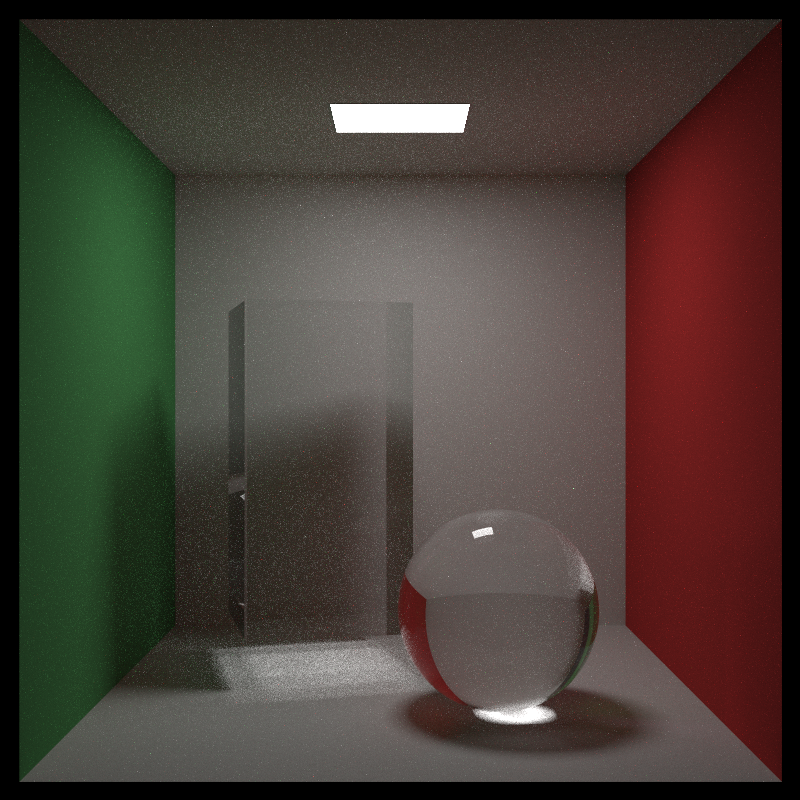I like to call myself a "hobbyist game developer." One, because I'm very interested in video game design (mechanics, art, story, structure, etc.) and development (software implementation, physical hardware, etc.). Two, I don't do it professionally. And three, I kind of always approach things the wrong way.
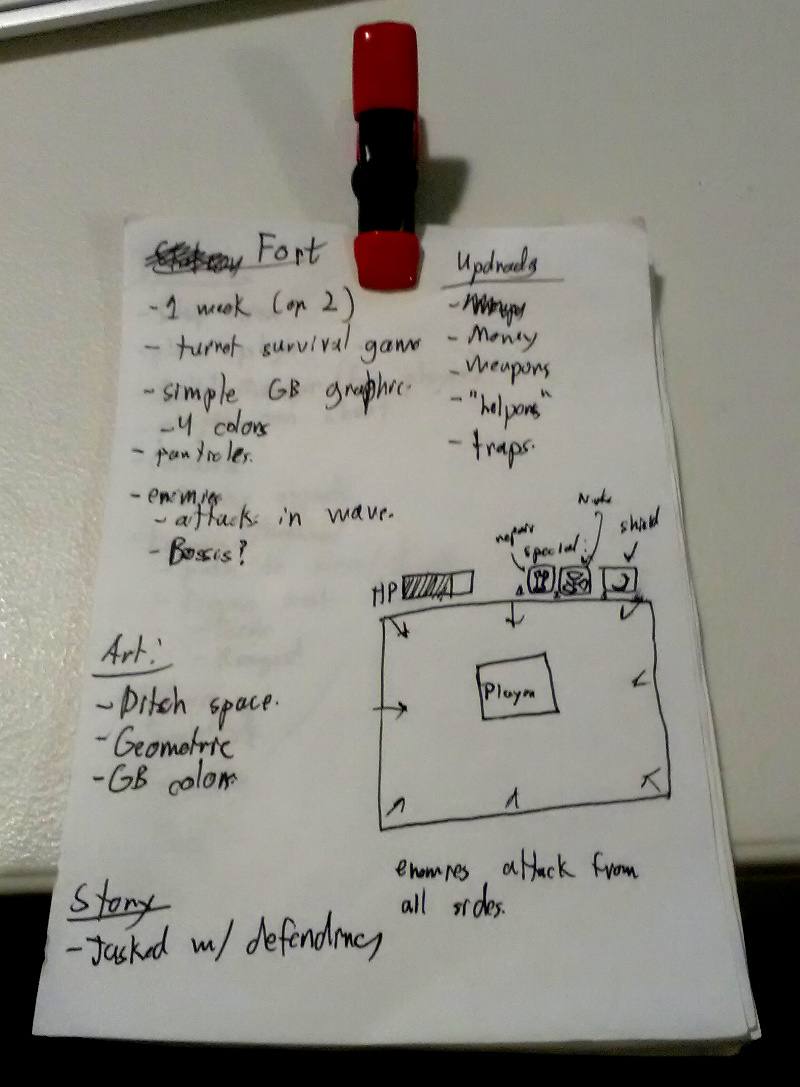
detailed game design docs.
Sure, I do like to draft up design documents of how I'd like the game to function. But I have this really bad notion of "I'm going to do everything by myself, and do it The Hardcore Way™!" Which always ends up (probably,) being that wrong way. What is The Hardcore Way™ you might ask? That's the little evil voice inside my grey matter saying such adorable things like "You should build your own game engine & framework around low level libraries! It would be way more efficient and fun!!"
Well, I don't think he's completely incorrect. But it's something I need to stop doing if I actually want to make games. A few weekends ago I was participating in the Linux Game Jam 2017 where I made Pucker Up. I decided to build the thing in Nim w/ SDL2 and raw OpenGL calls. And since Nim is quite young, I also had to make things for myself like a geometry and collision system. There's a common joke in the game dev scene, is that when you're at that tier, you're not even making a game. For a good two thirds of the jam, that is what all I was doing; no actual game mechanic implementation, just framework stuff. It sucked. And because of that time sink, I had to forgo adding a lot of content to Pucker Up that I wanted. All I could do were the basics.
I've always had the idea of sitting down and taking some time to learn an off the shelf game engine. But my experiences with the LGJ2017 is what prompted me to actually now try that. I know Unity is very hip and hopin' with the young and popular cool kid indies. Though playing games made with the engine, I have always had some issue with it running under Linux. So: pass.
What other engine has a massive following, loads of documentation, spectacular tooling, great performance, works on Linux and commercial success? Unreal. As a bonus, Epic Games is nice enough to let people peek into the source! Pretty cool.
![]() I'm also someone who likes to learn from taking classes or reading books. I'm not totally adverse to reading online tutorials, but I don't mind paying money for words. After taking a few minutes to query the Amazon for "Unreal Engine 4 book," I found this; Unreal Engine 4 for Beginners. It's written by a David Nixon. He looks quite young and it seems like this is his first book that he has ever written. Props to him doing that so early in his life. I couldn't find too much more about him online except for this snippet:
I'm also someone who likes to learn from taking classes or reading books. I'm not totally adverse to reading online tutorials, but I don't mind paying money for words. After taking a few minutes to query the Amazon for "Unreal Engine 4 book," I found this; Unreal Engine 4 for Beginners. It's written by a David Nixon. He looks quite young and it seems like this is his first book that he has ever written. Props to him doing that so early in his life. I couldn't find too much more about him online except for this snippet:
David Nixon is a professional software developer and amateur game developer who holds a degree in Computer Science from Florida Atlantic University. He started his career developing websites and providing SEO services for companies nationwide. He then dove into the world of mobile gaming. Recently, he worked as a web developer for a major SaaS company.
It was $50 for a print copy or $10 for a kindle. Being cheap, I went for the later option. Here's a special feature about the Kindle Edition of this book: You cannot read it in the Amazon Cloud Reader; you have to use a physical device. Normally when I'm reading a book that I assume has code samples, I like to read it on a computer and have it side by side with my text editor. I tried using emulation systems such as Shashlik and ARChon, but none of them worked. I wanted to try to contact the author, asking him why this was so or if he could provide me with a non-kindle copy, but he doesn't have a personal website setup or any public email address. I'm lucky enough to have a tablet where I was able to read this on, but this really sucks for programming books.
Anyways, so what is actually in the book? Here is the table of contents:
- Getting Started
- Basic Concepts
- The Level Editor
- Actors
- Blueprints
- Players & Input
- Collisions
- User Interfaces
- Audio
- Additional Topics
All of the chapters have the same structure: Introduce the chapter topics, divide into sections, then divided into further subsections, maybe a small example, and a quiz at the end. That's it. Rinse and repeat nine more times for nearly five hundred pages. That many pages might also seem like a lot but to be honest, I think I read the entirety of the book in less than an hour and a half. If you're wondering how I did that so fast, take a look at page 20:
I think this page is the one that has the most text on it, and it's not that much. Many of the other pages contain a lot of spacing for headers, paragraph breaks, images, section spacers, etc. If this book were to be in something like pt. 12 font size Times New Roman, I think it could be pegged at 150 pages maximum.
As for the actual quality of the content, there is not that much I can really say for it. It was an underwhelming read for me. Aside from the quizzes there was no engagement with the reader whatsoever. Sure there were some examples but they were sparse and all of them were with using the Blueprints Visual Scripting (more on that later).
I bought this book expecting it to be a sort of in depth tutorial. Every other game development book I have bought in the past 10+ years has been walkthrough where you build a game from the ground up. Unreal Engine 4 for Beginners left me with nothing other than a few common mechanisms (e.g. how to do simple character movement). Most of the content too was just mentioning what something does for you; not really much how to use it along with other things. The entire time I felt like I was reading simplified reference documentation. Nothing was detailed or highly constructed.
Now about the Blueprints. I'm not going to lie and say I'm fond of visual programming languages; I am very much so not. All of the entire code for this book was with Unreal's Blueprints. I was hoping to do some of that C++, but nope. It was dragging nodes and connections all of the way. I can understand the importance of visual scripting languages for people who work with Unreal yet don't have a traditional programming background but it was a real disappointment for me. On top of that Chapter 5, which is dedicated to introducing Blueprints was 1/6 of the entire book. And by no means is it a good introduction to how programming works. Most of the sections of this chapter would simply state "This is an <x> node, it functions like so." Most sections didn't have an example tied to them to better explain how the statement would work.
And… That's all I can really say about the actual content of the book. There was nothing that really made me a massive impression on me or gave me a good insight on how the Unreal Engine works or good practices with using it. Most of the information presented could have been scoured from the official UE4 documentation. In fact, I would say that this book was nothing more than a light reference manual than an actual tutorial. I really wanted to have this book show me how to build a game with Unreal; it did not do that.
I don't feel as if I got my money's worth out of this purchase. It was only $10 so it's not too much out of my wallet. But do avoid dropping $50 on the hard copy. I will cut Nixon some slack because this is his first book and does seem like a recent graduate. I wish him the best. He does also offer a course on Udemy about UE4, but I have not paid for it so I can't judge the quality of the content.
My conclusion is that I don't recommend getting it. I'll be looking for a different Unreal book in the future.
This is going to be a little different than only a usual book review; in fact, it's going to be a review of three books (that were part of a series). They are Peter Shirley's Ray Tracing mini-books. If you've been following my blog for the past few entires you may of noticed that I've been on a bit of a Nim binge lately. I've only been at it for about two months. So in an effort to learn the language better and to go through the books at the same time, I decided to write the book's code in Nim instead of the original C++. It turned out to be smoother than expected (though with some troubles along the way).
What is Nim?
I first heard about this language from the /r/programming subreddit. Every few weeks or so I'd see a link entitled "Nim v0.x.x released," or something like that. I didn't take a look into it until I saw a few of those and said to myself, "Alright, I think it's time to actually take a look at it." Since then, I've been doing most of my free time stuff in Nim.
The best tl;dr I can make to describe Nim would be "It's a python-ish language that compiles down to C/C++." There's definitely a lot more to Nim than just that. Reading from the project site is what really piqued my interests other than the native backend and syntax. There are features that give you a lot of control over the language. For example, you can use constructs such as macros and templates to define your own extensions to the language. One of it's most powerful aspects is how easy it can talk to C/C++ because well, Nim turns into that at the end of the day. Nim is able to take advantage of most of the existing C/C++ libraries with minimal effort. There already exist bindings for things like OpenGL and libSDL. There's even a framework to do web programming too.
I've seen a fair bit of comparisons with Mozilla's Rust and Google's Go, but I don't want to talk about that. The community is not crazy active like many other languages; it's more cozy if anything. Keep in mind that Nim is still very young, yet it's highly impressive what they've been able to do without any massive corporate backing. Yet.
Finding a Ray Tracing Book
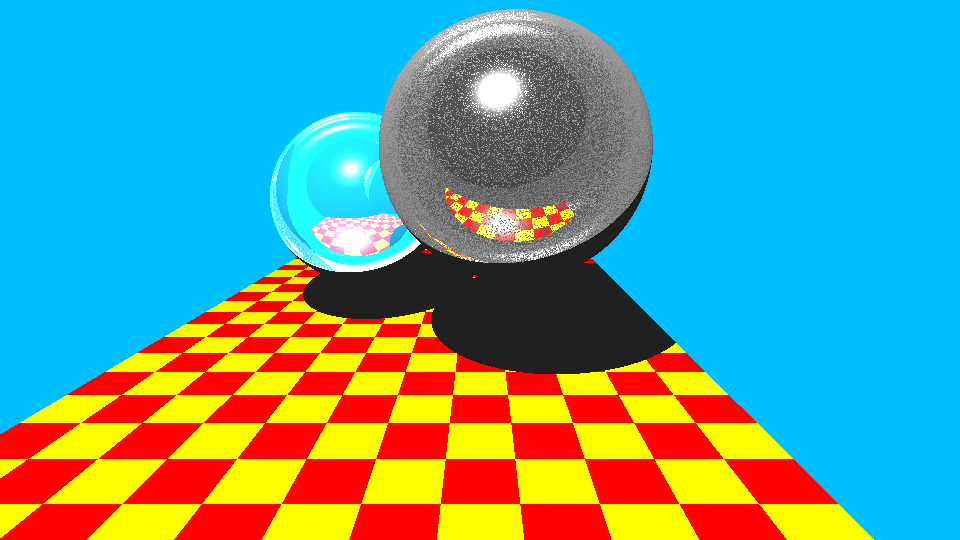
It didn't turn out so well for me.
In my last semester of university I took a grad level course in Global Illumination. With the Ray Tracer that I made, I wasn't too happy with the final results. I wanted to give it a second shot. So I headed to Amazon to look for a book. Yes, yes... I know there is a lot of good information out there already free on the Internet, but for some reason I just seem to learn better from reading in a book format. Anyways...
I saw a book called "Ray Tracing in one Weekend," at the top of the search. It caught my eye because:
- It was short
- It was inexpensive, three bucks (that's less than a cup of coffee)
- The code was in C++, and OS independant
- It mad the promise of building a functional Ray Tracer
- It came in a three part series. If I didin't like the first one, I could always ditch the second two books to find something else
I was sold.
Book 1 - Ray Tracing in One Weekend
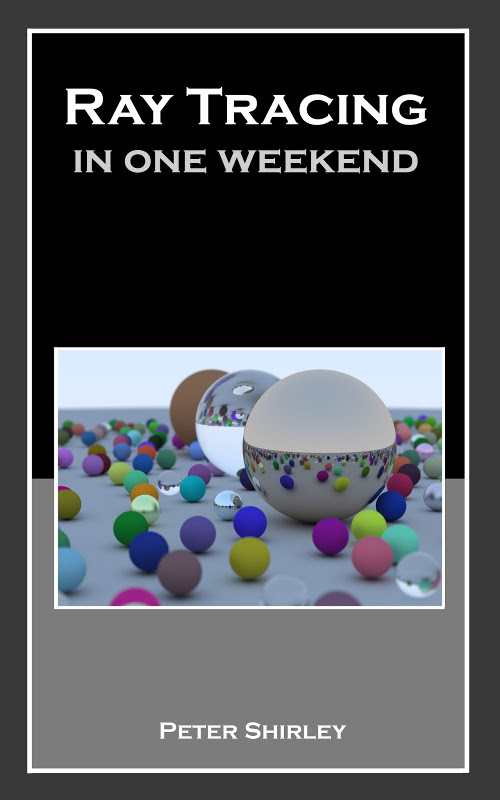 At the beginning of the book you will first have to set up your rendering infrastructure. All of the code makes no use of external libraries (except for one in the second book). That means having to build a 3D vector class, Rays, and other geometric goodies. Nim does come with it's own built-in 3D vector object, but I decided to forego using it so I could get the "full experience."
At the beginning of the book you will first have to set up your rendering infrastructure. All of the code makes no use of external libraries (except for one in the second book). That means having to build a 3D vector class, Rays, and other geometric goodies. Nim does come with it's own built-in 3D vector object, but I decided to forego using it so I could get the "full experience."
Now you might be saying "So how did you save renders then?" PPM. On standard out. Yeah, it's not my favourite image format either, but it got the job done and it is probably the simplest format to export without any extra libraries. And if you have a tool like ImageMagick converting it to something that people actually care about (e.g. PNG,) is trivial.
What's really nice about this book is how the author goes through step by step with you to build each component one at a time. I've had one too many tech books that I've slapped down $50 (or more) to only give me half-assed partial snippets and no walkthrough. Peter Shirley did a very good job of avoiding that. The code in this book had very few errors to none at all; a very great thing. With the amount of code in the book, I'd say you should be able to go through it in about three to six hours time.
I really wish I read this book before taking my course in Global Illumination. It would have made my life much easier and saved me a load of time and frustration.
Book 2 - Ray Tracing: the Next Week
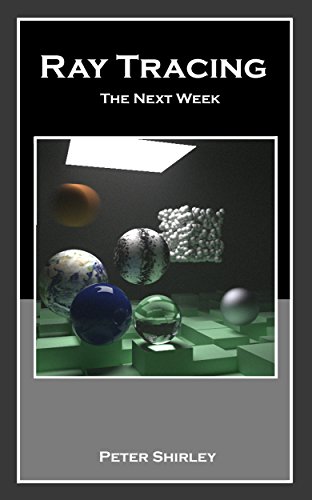 This is the book in the series that I learned the most from, but it is also the one that cost me the most agony and time.
This is the book in the series that I learned the most from, but it is also the one that cost me the most agony and time.
A lot of that could contribute to the fact that I was porting the code to a language that I was new to, but this book did have it's share of errors and missteps. For example, there were a few times where Shirley forgot to mention to make a change to something; one of the things that drives me up the wall when reading a tech book. Despite all of this I was able to get through the book, but it took way more than a week (the titled lied to me,) and I had to manually trace things through in the original C++ repo more than I should have.
Annoyances aside, this book goes over things like texture mapping (on spheres only), perlin noise, interpolation, BVH trees, and other stuff. What's more exciting is that actual emissive lights get introduced. In the first book there wasn't really any lighting, it was all ambient and sun-like. Now, we had real lamps. There are also a lot more scenes constructed in this book than the last. Including that famous Cornell Box. There is an external library introduced, but luckily it's stb_image.h; one of those magical single header file libraries. Binding it to Nim was a sinch.
I'd only recommend reading this book if you really are interested in Ray Tracing beyond what was presented in the first.
Book 3 - Ray Tracing: The Rest Of Your Life
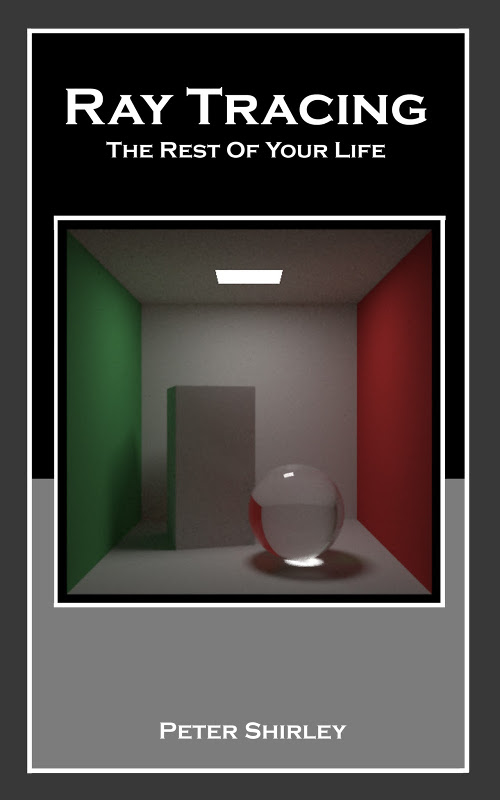 This one ended up being a lot more math and theory based, as you refactor the Ray Tracer into a Monte Carlo one. And... that's really much it. Every single scene that is rendered is based around the Cornell Box. It would have been nice to have a little more diversity rather than replacing a box with a glass sphere or making one a mirror-like surface, but it doesn't take away from what's talked about.
This one ended up being a lot more math and theory based, as you refactor the Ray Tracer into a Monte Carlo one. And... that's really much it. Every single scene that is rendered is based around the Cornell Box. It would have been nice to have a little more diversity rather than replacing a box with a glass sphere or making one a mirror-like surface, but it doesn't take away from what's talked about.
What's really nice about this one is that it was a much quicker read for me than the second, less frustrating, the images rendered way faster, and ended up looking much better to boot. There was only one problem; in the final chapter the author did that thing again where he forgot to tell you to update something. I don't think it would have been so bad if I did the thing in C++ instead of Nim. I'll get to why later...
All in all, I would actually recommend this one over the second just a little bit more. Some of the things in it could fly over your head, but there were next to no errors in the book (just one).
Book Series As A Whole
As I said before, I wish I had a copy of the first book before going into my course where I had to build a Ray Tracer. It covers many of the necessary basics plus some extra fun things.
All of the issues that I bumped into in the second one were quite jarring. I've sent a laundry list of them to Peter Shirley. He's been very responsive to all of my emails and has fixed issues with his books in the past. Expecting him to clean them up during the Thanksgiving-Christmas-Hanukkah-Kwanzaa-Festivus-New Years blitz (a.k.a. November & December) is not a fair demand, but he should eventually. Once these get fixed up I think it will be a much stronger series.
Except for the errors, the source was of a good quality. It was mostly clean, readable, and simple. The only thing that I didn't like was the organization of the code. I know you get what you pay for ($3) but it wasn't really that well structured. It made the software engineer in me hurt a little. The code was also provided as one big lump in a GitHub repo. Other tech books I've read have been nice enough to divide up the progress from each chapter in their own separate folder. This would have been good to do instead.
I'm a little saddened this didn't go over other things like the BRDF or a bit of ray marching. It would have been better to have more in the third book than only a Monte Carlo renderer. I also don't think the title of the last book is really accurate if you choose to do more Ray Tracing after reading it. This book series should not be treated as a replacement for a university course; I learned a lot more about ray tracing and computer graphics at school.
With these negatives, I think the positives out way them and make the series worth the money to pay for it.
What it was like doing this in Nim
There always seems to be a relevant XKCD for every situation. In the realm of compiled languages Nim really made me feel like I was flying again.
As I said before, I did this book in Nim as an excuse to learn the language better. I've made a few toys with Nim prior, but I felt working on a larger (iterative) project would force me better understand the language. At the end, I did learn a lot more..
Translating between C++ and Nim wasn't that difficult at all. The book's source wasn't complexly constructed in areas of OOP, and Nim's OOP functionality is still fairly basic, so there was almost a one to one correspondence with what I would have to write. When there was a C++ class, I would typically turn that into a type CLASS_NAME = ref object of RootObj. It would hit most of my needs but one time it came back to bite me in the butt. Looking up witch Nim proc to use in place was something a pain, as Nim's documentation isn't the best at the moment.
Things always felt very fluid and fun for me. It felt a lot like I was writing Python code that was type checked. The operator overloading is also some the easiest I've seen in any language. And because of having to use stb_image.h I got a taste of how to work with the foreign function interface. Heck, I even ended up doing a proper wrapper of the library.
So how that ref object of RootObj got me... I would translate all of the C++ classes using this. That would create reference counted pointer to an custom object I defined. Upon object creation, which would be stored in dynamic memory. When I was first working on the Cornell Box I got this:
Yeah, that's pretty bizarre. That back box is off to the right (through the wall), yet it's shadow and diffuse reflections are on the room walls and floor. After pulling my hair out form running through the code I finally figured out that ref object of RootObj was what perpetrated it (or how I used it), along with this snippet:
method hit*(ry: rotate_y, r: ray, t_min, t_max: float, rec: var hit_record): bool=
# I thought this was copying the vec3 data, but it wasn't. It was copying the pointer...
var
origin = r.origin()
direction = r.direction()
# origin and direction are modified after this which caused the issue...
I wasn't creating a copy of the 3D vector, I was modifying the original vector… After that I changed that vector class over to a simple object.
Another problem I had with Nim is that it doesn't yell at me as much as C++ does. When I was working on the last book, my renders were coming out like this:
"How the heck is that glass sphere turning into a black hole?" went through my mind. This also made me spend too much time chasing the errors down in the wrong places. Partially, this issue stemmed from Peter Shirley not reminding me in that last chapter to update the dielectric::scatter() method. But when I changed the prototype for the base method material::scatter(), Nim didn't yell at me to fix the child methods too. It just used the base method instead, which would return black. When you change a base method's prototype in C++ the compiler will remind you to change all the children too. For once, I wish I was being screamed at.
There is also some other odd behavior I want to look further into too. In the second book we built a BVH Tree hierarchy to store the scene info, as to make the ray collisions much faster than checking each object one by one. Storing the hittable objects in a sequential list was faster than searching the BVH Tree. It could be my implementation of a bounding volume hierarchy, but I'm sure it's functionally correct.
As for the performance of the Ray Tracer. It's not as fast as the C++ one it was ported from, though it is still pretty good. If I were to have written this in Python (what Nim resembles), I think the images would still be rendering well into my 80s. The port that I have is definitely not the most riced thing possible. There's probably a ton of other optimizations that can be made. But here are some comparisons:

Commit was: "fd77499840b4a93441b4c9d772258da85fecc265". Resolution was 1280x800. "ns," stands for number of Rays/Samples per pixel. All were done on a Desktop Intel i5 machine, single core w/ no threading. The Linux "time," utility was used to benchmark. I think the performance slowdown with book 2's Nim implementation has something to do with the BVH node. I'll be investigating it and hopefully fixing it.
Nim is still very young so I don't think it's fair to be overly critical, and I'm also very new to the language myself. I will continue to do more things in Nim as I really like it.
If you want to learn more about Nim here is the website and here is a good place to start. You can find the Nim Ray Tracer here (GitHub mirror). And if you're interested in the books, here are their Amazon pages:
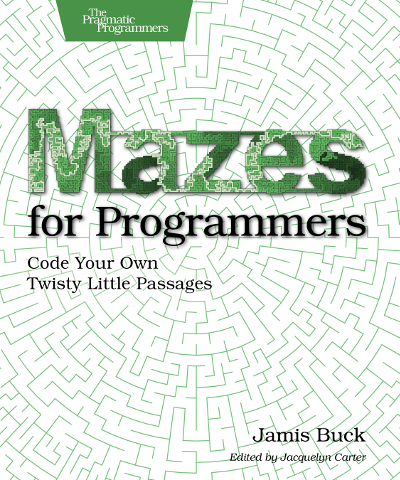 I remember first seeing this book in an newsletter from the Pragmatic Bookshelf a year ago. It caught my attention because it seemed like a publication that was on a very niche topic yet fun. I didn't get a copy of it when it was released because I was busy at the time with schoolwork (and then forgot about it). Though a month ago I was down in on a weekend trip to D.C. and I saw it in a bookstore I visited; I decided to buy a copy since I have a lot more free time right now. Being interested in game development, computer graphics, and procedural generation, I found this book to be a delight to read.
I remember first seeing this book in an newsletter from the Pragmatic Bookshelf a year ago. It caught my attention because it seemed like a publication that was on a very niche topic yet fun. I didn't get a copy of it when it was released because I was busy at the time with schoolwork (and then forgot about it). Though a month ago I was down in on a weekend trip to D.C. and I saw it in a bookstore I visited; I decided to buy a copy since I have a lot more free time right now. Being interested in game development, computer graphics, and procedural generation, I found this book to be a delight to read.
The Code
All of the code for each chapter (except for a POV-Ray file) is in Ruby. My best guess why the author (Jamis Buck) chose to use Ruby is that he is a former contributor for the core team on the Rails projects. His GitHub page is also littered with Ruby projects, so I assume it's what he's most comfortable with.
If you have zero experience in Ruby, fear not, neither did I before reading this book. Not knowing Ruby should not be an obstacle to understand what is going on. As long as you have a lot of experience with many different languages it shouldn't be difficult. Most of the source reads like Pseudocode. Only a few times did I find myself checking the Ruby documentation (e.g. Array.sample, or Ruby Blocks) to understand something unknown. If you are looking to get familiar with the syntax of Ruby (or only to get your feet wet), I think this is a good start, but keep in mind that author's goal is not to teach you Ruby. Personally, I would have preferred the sample code to be in Python, but that's just me.
Of the tech books I've read, I've gone through many that have given me incomplete code examples (i.e. snippets) or code that breaks on running it. It's one of the most frustrating things out there! Buck and the rest of the team that worked on this project did a very good job on making sure all of the code worked as it should. I wasn't able to find a single issue with anything. All of the code provided were complete examples. A+
Everything builds on top of what you've done in the previous chapter, so I don't recommend skipping around. Lots of inheritance and code reuse, which is good!
The Content
 Most of the book's pages are dedicated to the generation of mazes in a 2D space. In the beginning he talks about some simple algorithms like Binary Tree and Sidewinder, but later moves on to other methods that generate some more interesting maze designs. There really isn't much of anything in the realm of solving mazes outside of discussing Dijkstra's Algorithm. I really wish there were more included.
Most of the book's pages are dedicated to the generation of mazes in a 2D space. In the beginning he talks about some simple algorithms like Binary Tree and Sidewinder, but later moves on to other methods that generate some more interesting maze designs. There really isn't much of anything in the realm of solving mazes outside of discussing Dijkstra's Algorithm. I really wish there were more included.
There was more covered than maze generation for rectangles. I found the sections on polar, triangle and hex grids really fascinating, but the Weave grids were the best in show (to me at least). There was also some pages for fitting mazes to odd shapes and designs.
In the later chapters Buck does show you how to generate a three dimensional maze (and talks a tad bit about 4D), but I found the representation of them to be a little difficult to follow (little red arrows are used to shift dimensions). I would have favored something with 3D graphics instead. That's a lot more complicated than 2D drawings and beyond the scope of this book though
One thing that was really well done was how algorithms were described with step-by-step drawings. More books really should be doing this. I've seen it too many times were only a single image or two are given when really seventeen should be provided to show a run-through of an algorithm. This made the algorithms really easy to understand without having to read any code.
Extra Cool Things
Something that I really appreciated is he included some code on how to display the mazes in a terminal window. These only work for the 2D rectangular mazes (the early chapters), but I still found it nice since I love ASCII art.
At the end of the book there are two appendices that cover the maze algorithms explained. The first one is an overview of what each algorithm does along with a picture of it. The second one goes over some benchmarking/statistics of the various algorithms; very useful.
Final Thoughts
This book was worth the money I paid for it. I don't think I'll be using anything I've learned in it immediately, but I know I will sometime down the road in my video game endeavors. It's not a definitive source on mazes but a really good starting point. I really would have loved some more chapters on maze solving. One on interacting with the puzzles we generate would be cool too, but that falls more into game programming. It has also done something for me that I've never expected; opening me up to Ruby.
It's been a while since I've read a programming book that wasn't overly dry. Everything flowed nicely and kept me interested in learning what was coming next. I really recommend reading this book if the subject matter sounds interesting to you. It will be enjoyable.

